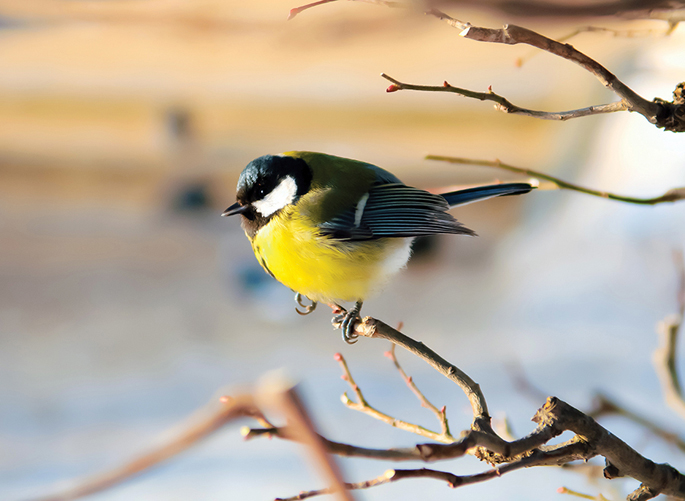
One thing’s for sure — you’re well aware of all the benefits of a pondscape or water feature. Sitting nearby relaxes you, soothes your nerves and lifts your spirits. The sound of moving water takes you to a tropical place, transporting you away from your worries each time you hear it.
Maybe you think that it couldn’t get any better, but you might be missing an element that could heighten your enjoyment and provide even greater benefits to you and your customers. Have you ever thought about how effectively a pond attracts and sustains the living things of the natural world? Consider integrating the necessary elements for a habitat that supports other forms of life — specifically, birds.
Why cater to birds?
We often take them for granted. After all, birds exist everywhere, from the depths of the forests to the desolate deserts to the crowded inner cities. So why would you want to encourage birds to visit your backyard haven? There are several reasons why you’d want to be more in tune with these fascinating, warm-blooded creatures.
Birds appeal to most of the senses, with enchanting and varied songs and calls, beautiful plumage and captivating behaviors. Some species will go through their life cycles within your yard, nesting, raising their young and teaching them how to survive on their own. Some of them leave for the winter and miraculously appear again in the spring. The same birds often return to the same yard year after year. They calm and entertain you while they perform valuable services, like eating harmful insects and helping maintain biodiversity within your yard.
Bird lovers probably know this instinctively, but according to Birds and Blooms magazine, an interest in wild birds can provide major health benefits and enhance the quality of life for just about anyone. That’s pretty compelling by itself!
If you enjoy sitting by a pond, you might have noticed that birds often visit to drink and splash. Water is essential for birds, and by making it available, you’ve provided one component of a welcoming habitat for them. The other three elements are cover (or shelter), space and food.
Water
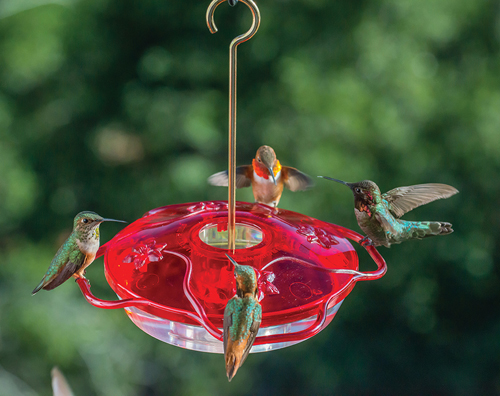
A pond should naturally attract birds for hydration and bathing. Without any adaptation, it might perfectly satisfy the birds’ requirement for water. However, birds need shallow water, so the addition of rocks or sand along the edge of a pond will provide a non-slippery entry that will make a big difference in the number of birds it attracts. Dripping, misting, spraying or flowing water increases their interest and enjoyment.
Shrubs, bushes and vegetation that birds can use for nesting, roosting and protection from predators constitute types of cover, or shelter. Flowering plants and shrubs also contribute seed and insects to birds’ diets. Their instinctive need for protection from predators often dictates their behavior in an area. Birds are more willing to visit food sources when a tree or shrub is close by — a range of 20 feet or less. You’ll notice that some birds will take a seed and fly to a tree to open and eat it, staying out of full view from hawks. Landscaping with birds in mind has become such a trend that there is even a word for it — birdscaping.
All living beings need sufficient space. Even with limited space, there can be room for courtship, nesting, foraging and flight. Some cavity nesters use nest boxes, while others prefer natural cavities in trees. Many others commonly build on limbs in shrubs and trees. A pond’s surroundings become their world, especially while they are nesting, raising their young and teaching survival skills to the fledglings. You’ll witness them attending to nests, gathering seeds, capturing insects and feeding their young within the reaches of your yard.
Food
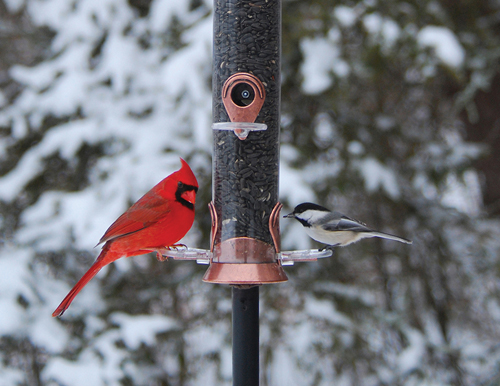
Feeding birds is the easy part. Wild birds eat seeds, insects or both. Flowering plants and shrubs provide seeds for birds, but add a bird feeder or two, and you can expand the variety of seeds on the menu. This will increase the bird population and number of species, delivering the many benefits of backyard birds.
The basic foods that can be offered as feed are sunflower seed, Nyjer, peanuts, suet, nectar and mealworms. Seeds are also available as mixes of varying quality. There are bird feeders specifically designed for each of these different food types, and the label should clearly disclose what type of food to use and what kinds of birds you are likely to see.
Feeders Make It Easier
Fill a tubular sunflower feeder with black oil sunflower seed. This is the single most attractive seed that appeals to the greatest variety of birds. The next feeder type to add is one designed specifically for Nyjer, which is a favorite of finches. Nyjer, formerly known as thistle seed, is a small, shiny, black seed that is reputed to be disliked by squirrels. Note that a feeder filled with Nyjer seed mixed with sunflower chips is a squirrel magnet and will require a squirrel deterrent. Fresh, quality food makes a difference and will attract more birds, as well as a greater variety of birds.
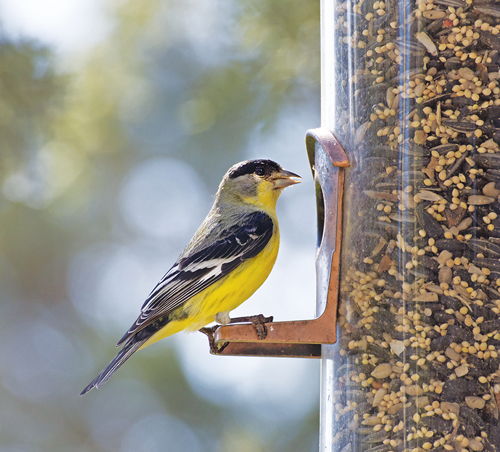
Tubular feeders come in many sizes, and you can choose from dish and hopper feeders to appeal to a variety of songbirds, from chickadees to cardinals. Some birds prefer tube feeders; others like the flat surfaces of seed trays and dish feeders. Place feeders near shrubs or trees to provide safety from hawks and other predators — not directly over your pond or water feature. If a tree doesn’t provide the perfect spot, pole systems are available that allow the perfect placement of bird feeders, close to cover and within sight. Other accessories like hangers, trays, squirrel guards and brushes are available to adapt bird feeders as needed. If squirrels are a problem, look for products that prevent them from climbing the pole, or just use squirrel resistant feeders.
Hummingbird feeders and suet cages serve as additional options. In general, hummingbirds come north in April and May to breed and raise their young and depart in September and October for Central and South America. Hummingbird feeders hold sugar and water nectar, which is easy to make and feed. Suet cages hold standard blocks of suet and are attractive to woodpeckers.
Just as you need to care for your pond, remember that bird feeders need a little care, too. Disassemble and wash them when they get dirty. Allow to dry thoroughly before refilling. Dirty feeders are not only unpleasant to look at — they can also harbor bacteria and germs that can make the birds sick. Use a long-handled bird feeder brush to make cleaning tube feeders quick and thorough.
The Bigger Picture
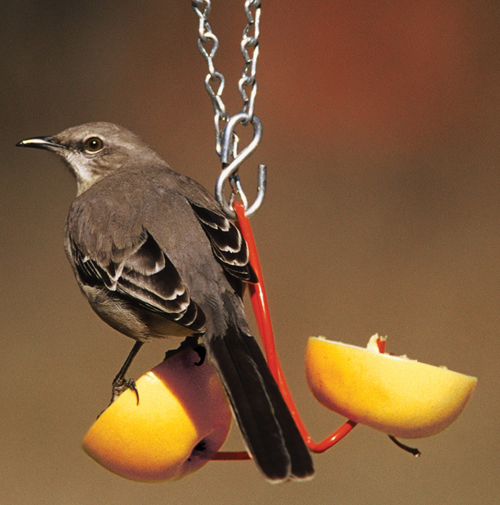
Besides enhancing the experiences of a backyard pond, when you cater to birds, you are doing much more. It is readily accepted that loss of habitat has adversely affected bird populations, and many species worldwide are in decline. Studies have shown that when wild birds have ready access to food in the form of bird feeders, more birds survive. A higher percentage of baby birds lives long enough to leave the nest when food is readily available, reducing the time the parents spend away from the nest foraging. The birds studied had greater overall health, with better fat reserves, lower evidence of stress, better nutrition and more normal hormone levels. The habitat and the food you provide is a real life-saving benefit to all the birds that inhabit a yard, not to mention the fact that it’s a multifaceted, year-round benefit for the pond owner, too.
In 2005, Droll Yankees introduced an initiative that simply states the importance of feeding birds — “Just feed birds, and make a world of difference.” It’s true, because when you feed birds, you help more baby birds survive. More birds will eat more insects, so fewer chemicals will be needed to control them. Using fewer chemicals makes the environment healthier for you, your children, your pets, the water supply — and, of course, wild birds. We can make a world of difference, one bird feeder at a time.
Perhaps you’ll appreciate the traditional pondscape with a new perspective. By attracting wild birds and enjoying their gifts of color and song, you’ll play a critical part in a bigger effort to support species that are currently declining or in jeopardy.


